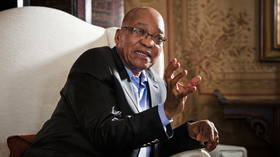China may be building more than 100 new nuclear missile silos in its western desert... but only in response to American aggression

US reports claiming Beijing is greatly strengthening its nuclear arsenal can’t be confirmed, but it wouldn’t be surprising, given Washington’s threats against Beijing and its military build-up in the region.
Much has been said recently about an exclusive report published in the Washington Post analysing satellite imagery that purports to show China building intercontinental ballistic missiles in its northwestern province of Gansu, claiming that China is gearing up its ‘second-strike capability’ and in turn strengthening its nuclear arsenal.
Also on rt.com In a world gone mad, China must build MORE NUKES to make disarmament possibleThe report follows a running theme in US military circles that Beijing poses a growing “nuclear threat” to the United States, with Pentagon spokesman John Supple telling CNN: “Numerous Defense Department leaders have testified and publicly spoken about China's growing nuclear capabilities, which we expect to double or more over the next decade.”
On the other hand, pro-China voices on Twitter were quick to dismiss the report’s findings and argue that the construction sites were, in fact, wind farms. While it’s difficult to verify these claims, of course, it’s likewise important to remember that, beyond US hysteria, China’s nuclear arsenal is tiny in comparison to America’s (currently some 250 to 350 warheads versus 3,800), and it operates according to a ‘no first use’ policy (Washington’s doesn’t).
Do you know why Trump call it “Fake News”? It’s just a wind farm! 😂 @washingtonpostpic.twitter.com/pLs46njDvm
— Shen Shiwei沈诗伟 (@shen_shiwei) July 7, 2021
It would be unsurprising if growing military tensions between the two states and a perceived fear of encirclement by the US and its allies was pushing China to strengthen its military hand. Although it would be ridiculous to accuse China of a ‘Cold War-style’ build-up, it makes logical sense for Beijing to ramp up its capabilities.
The original Cold War between the United States and the USSR was defined for most of its history by a dramatic increase in nuclear missile capabilities on both sides, which, at its peak in the 1980s, saw Moscow accumulate almost 40,000 warheads. This dramatic stockpiling created a constant fear of global nuclear annihilation and was pushed to the brink through episodes such as the Cuban Missile Crisis, yet, ultimately, the equilibrium of ‘mutually assured destruction’ ensured that conflict between the two superpowers never broke out.
This is not comparable to the current tensions between China and the United States. While Beijing has had nuclear weapons since 1964, it has been largely reserved on its objectives of maintaining a ‘basic deterrent’ of around 300 warheads – comparable to the numbers held by the UK and France.
Its nuclear goals are not as America’s are, to uphold military hegemony over the rest of the world, but to protect its national sovereignty and territorial integrity. That, of course, includes obvious red lines such as Taiwan, and this could be part of the reason it may be increasing its numbers and ‘flexing’ its approach as tensions with the United States rise.
Washington’s bellicose language towards Beijing, and its growing militarisation around China’s periphery, including expanding its relationship with Taiwan, is increasingly aggressive. As a report from a Washington foreign policy magazine put it: “The US military is encircling China with a chain of air bases and military ports.” Faced with such threats, what nation would not seek to up its defence capabilities?
Also on rt.com Western governments & businesses are about to feel the heat of Chinese countermeasures against sanctions... and they won’t like itThe Washington Post report is correct to frame China’s potential activities as a reaction to these developments, and to call it a ‘second-strike’ capability, though the weapons’ use to deter a Taiwan contingency is not unimaginable.
The missile silos’ location in Gansu is strategically significant. First, the province is situated deep into China’s interior, towards Xinjiang. It’s an isolated desert region that is west of the core of China’s population and away from its industrial and urban sprawl. This reduces liability for those areas in times of conflict and makes the weapons easier to hide and disguise.
Second, the location makes it far more difficult for enemy fighters to reach and disable the silos. Could US fighter jets go thousands of kilometres inland into China to conduct pre-emptive strikes on military infrastructure and not be shot down? They have clearly been carefully placed to play to China’s geographical strengths.
Thirdly, Gansu, being near Xinjiang and Tibet, may have been chosen to cater to another opponent as well as the United States. Although we are talking here about what are apparently intercontinental ballistic missiles that can travel more than 9,000km (5,600 miles), allowing them to reach the American mainland, they could also reach greater continental Eurasia and the Indian Ocean, giving options against the US’ Indo-Pacific Strategy as a whole and Beijing’s geopolitical rival in New Delhi. This did not go unnoticed in the Indian media.
In this case, one might describe China’s potential nuclear build-up, if proven, as a deliberately ambiguous effort undertaken in reaction to the shifting military environment in the region and not an effort to pursue nuclear domination or hegemony, but to tilt the balance of power in its favour and strengthen its leverage in the surrounding regions.
Ultimately, if the United States is seeking to increasingly equip its allies, strong-arm them into anti-China coalitions, pursue a growing number of military exercises in and around the Indian and Pacific Oceans, and press on all of China’s insecurities, of course, Beijing is going to react, but it will do so, as it always does, in a more subtle and less overt way.
There will be no nuclear confrontation between the United States and China, and nor does Beijing anticipate one, but the route towards some form of arms build-up has been inevitable for a long time. Don’t expect China to showcase this or publicize its true capabilities, but rather to keep its opponents guessing – and on their toes.
If you like this story, share it with a friend!
The statements, views and opinions expressed in this column are solely those of the author and do not necessarily represent those of RT.















